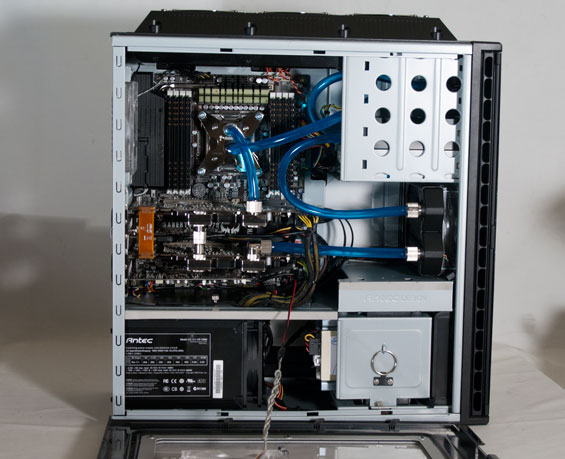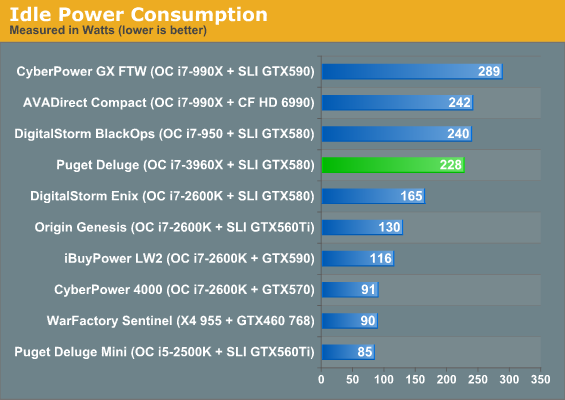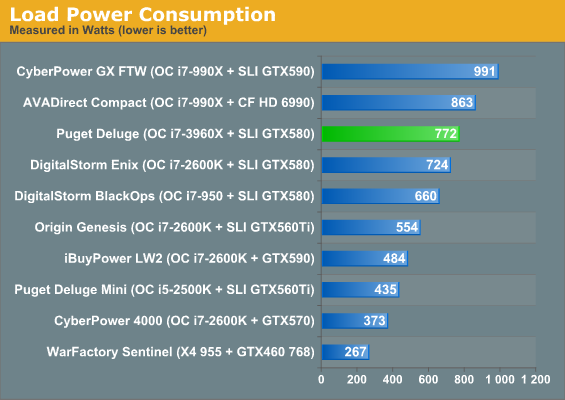Puget Systems Deluge: Revisiting the Art of Custom With X79
by Dustin Sklavos on November 24, 2011 12:00 AM EST- Posted in
- Systems
- Gaming
- Intel
- Puget Systems
- mid-tower
- Water Cooling
- NVIDIA
Build, Heat, and Power Consumption
Cutting to the chase, the Deluge's physical build quality is, as has been the case with all Puget Systems machines we've tested, basically unimpeachable. The modifications made to the Antec P183 enclosure are clean, and the wiring and liquid-cooling routing are top notch. I was actually impressed with the work they did installing a window on the side panel; the P183's inside panels are acoustically padded in a way that might make modification challenging, but you wouldn't know it to look at the Deluge.
I'm also impressed they were able to make a computer with a window on the side and glowing blue fans and tubing not look incredibly gaudy. While I think blue LEDs are starting to feel played out, this looks and feels like a powerful custom machine. It's hard not to be taken aback when you look at it. The thing weighs a ton, but what did you expect?

Where Puget Systems unfortunately falters is the overclock. They don't allow the idle voltage to drop on the i7-3960X, forcing it to constantly run between 1.41 and 1.46 volts. Ignoring for a moment that those are pretty high voltages (and undoubtedly necessary to hit the punishing 4.6GHz overclock), I'm actually disheartened to see a company that's normally a wonderful citizen where power consumption is concerned trip up in this area. I gripe about lazy overclocks pretty frequently, but this is really a situation where they should've known better and done more tuning. Blame the newness of the platform if you want (which is almost certainly a factor), but the result is a processor that's running hotter at idle than it needs to, a cooling system that has to work a little harder than it should, and power consumption that's pretty dire.

Despite the custom liquid-cooling loop with a 360mm radiator and an additional 120mm radiator in the front, the i7-3960X still runs a bit toasty under load, and those idle temperatures are quite poor. Again, though, that's what happens when you dump so much voltage into a processor and don't let it scale down at idle. The Deluge essentially needs the liquid-cooling loop to maintain the overclock. Higher temperatures generally go hand in hand with higher power consumption, and that's precisely what we see.


Given the improvements in SNB-E and X79 relative to Gulftown and X58, we were hoping for a better showing. At idle, only the last generation Nehalem in the DigitalStorm BlackOps and Gulftowns in the CyberPower and AVADirect rigs are worse, and the CyberPower and AVADirect rigs are both powering four GPUs.
Things get even worse under load; only the quad-GPU rigs running Gulftown are able to draw more power than the Puget Deluge. You can argue that DigitalStorm's Enix makes things at least look a little better, but we actually took DigitalStorm to task over the overclock in their system: its voltage idles low but shoots through the roof when the i7-2600K is placed under load.
I'm going to keep dinging boutiques on these overclocks until they start paying attention: "fastest" does not mean "best," especially not when it results in this kind of heat and power consumption. It's one thing to set a speed record for the Futuremark ORB or an overclocking competition, but it's quite another matter to sell a system designed to run daily tasks for the next few years. The Deluge is plenty fast, but long-term it could really benefit from some additional tuning.
















72 Comments
View All Comments
Dustin Sklavos - Thursday, November 24, 2011 - link
If I could keep it, why would I give it to you? ;)vol7ron - Thursday, November 24, 2011 - link
Umm, possibly a prize give away to the more active readers/forum participators/commenters?Onslaught2k3 - Thursday, November 24, 2011 - link
"We start at the top with Intel's shiny new top-of-the-line Core i7-3960X. Built on a 32nm process, the new chip features eight hyper-threaded Sandy Bridge cores and 20MB of L3 cache, although in this chip 5MB of L3 and two of the cores are disabled."to this
"We start at the top with Intel's shiny new top-of-the-line Core i7-3960X. Built on a 32nm process, the new chip features SIX hyper-threaded Sandy Bridge cores and 20MB of L3 cache, although in this chip 5MB of L3 and two of the cores are disabled."
Can't anyone willing buy the same system AND build it themselves at less than half that cost? Nice review though, Dustin.
Death666Angel - Thursday, November 24, 2011 - link
Read the SNB-E review:"If you look carefully at the die shot above, you'll notice that there are actually eight Sandy Bridge cores. The Xeon version will have all eight enabled, but the last two are fused off for SNB-E."
This version is a hexacore, not a quad-core as you say. But the chip it is built on actually has 8 cores.
Onslaught2k3 - Thursday, November 24, 2011 - link
Ok, no corrections are needed. I wonder if at some point a BIOS-based unlock would be available for this chip exclusively... since... you know... it's over $1k in price...JarredWalton - Thursday, November 24, 2011 - link
Pretty sure they're fused off; AMD has allowed core unlocking on some chips in the past, but I don't recall that from Intel any time in recent history.mfenn - Thursday, November 24, 2011 - link
Anybody want to take bets on whether or not Dustin can make it through an entire article without using the word "dire"?Dustin Sklavos - Thursday, November 24, 2011 - link
Outlook...dire. ;)ckryan - Thursday, November 24, 2011 - link
When will the Dustin Sklavos Review kit become available for purchase?You get a case with dire cable management, a laptop with a dire TN panel, and an AIO with dire thermals AND a dire TN!! It's a can't-win proposition.
I don't have a beef with boutique builders putting boutique prices on boutique builds. I do have a problem with laying out that much feddy and not getting an Asus Xonar Essence STX, but instead receiving the DX. If I using someone else's money to buy this system I could easily massage it into the system is could be. I could adjust the overclock my damn self.
FWIW, I think it's hard to really make a high end X79 build, when you get most of the actual features from a P67/Z68 chipset.
wickman - Thursday, November 24, 2011 - link
1920x1080 is a pretty low resolution to be using for a system powered by dual GTX 580, 590s, 6990s, and so forth. I don't think anyone running this type of gpu subsystem would possibly be running such a low resolution when the cards themselves are capable of running games at 2560x1400, 2560x1600, or higher when used with multiple panels.Would be nice to see what these systems were able to do at much higher resolutions.